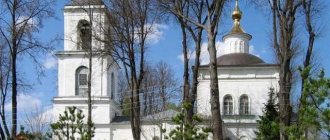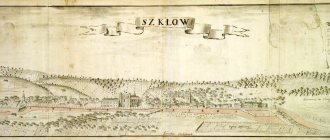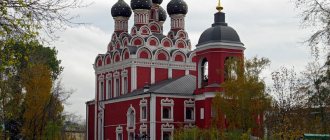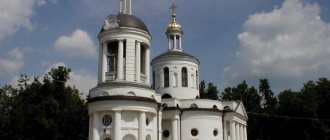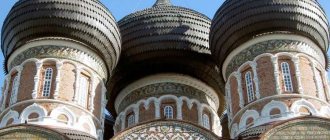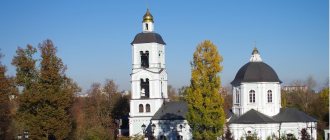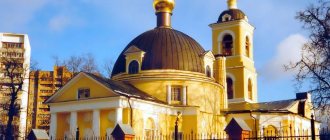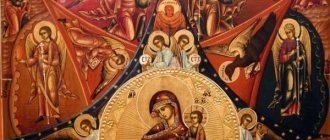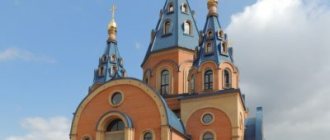Train schedule Moscow (Kursky Station) → Podolsk
Train schedule Podolsk → Moscow (Kursky Station)
Train schedule Tsaritsyno → Podolsk
Train schedule Podolsk → Tsaritsyno
The Church of the Sign of the Blessed Virgin Mary in Dubrovitsy is a special monument of church architecture of the late 17th century. Looking at this magnificent architectural monument, it is difficult to believe that it is located in Russia, very close to the capital, in the Podolsk district of the Moscow region. The history of the temple, the names of the masters who created this masterpiece of architectural art are still not precisely known.
History of construction
At the beginning of the century, Kuntsevo was a holiday village on the outskirts of Moscow. This historical place was owned for a long time by representatives of the ancient noble family of the Naryshkins. In 1744, Alexander Lvovich Naryshkin decided to build a stone church on his estate, which was intended as an estate church.
Temple of the Sign in Kuntsevo, Moscow
Construction of the building began in July 1744, and was completed in the same year by the 20th of November. It had a cross shape. The central dome rose in the middle, and the other four were on the sides of the cross (later one of the domes was dismantled).
The new church was consecrated by Bishop Joseph (Volchansky) on the day of the celebration of the icon of the Mother of God “The Sign”. You can read about this event on a cast-iron medallion mounted in the western wall of the existing temple. This wall was previously part of the Naryshkin church, but then it was eastern.
After 2 years (in 1746), Alexander Lvovich dies, and Kuntsevo eventually passes to his son Lev Alexandrovich Naryshkin. Since the church was a manor church, “there were no peasant households in the parish.” The number of parishioners increased after 1767.
At this time, Lev Alexandrovich received permission from the church authorities to assign the inhabitants of the village of Mazilovo (the village was also the property of the Naryshkins) to the Znamenskaya Church. By the beginning of the 19th century. Residents of the village of Davydkovo also received the opportunity to visit it, which significantly increased the church parish.
The Russian-French War of 1812 became a great test for the church and its parishioners. It was located near the Mozhaisk road along which French troops were moving, so it was completely plundered. Of all the rich church utensils, only one silver censer has survived.
However, the icons, which were of no value to the invaders, remained in the temple, albeit without their expensive frames. In the desecrated temple, services could only be resumed in April 1813.
In the 1820s. The church building has undergone reconstruction. At this time, on the site of the fifth dome, located on the western side, a stone bell tower was installed.
The Naryshkins owned Kuntsevo for a century and a half. In 1865, they sold the village to the merchant Kosma Terentyevich Soldatenkov, a manufacturer, book publisher and philanthropist. Despite the fact that Soldatenkov was an Old Believer, he continued to maintain the temple at his own expense.
In 1873, Kosma Terentyevich built a crypt at the temple, and the following year he erected a sacristy on the site of the southern porch. In 1901 (after the death of Kosma Terentyevich), the estate became the property of his nephew Vasily Ivanovich Soldatenkov.
Over time, the parish grew, and the building could no longer accommodate everyone. Therefore, it was decided to rebuild it. In 1904, Vasily Ivanovich sent a request to expand the temple. But the decision was made not to rebuild the old one, but to erect a new building.
The building was designed by academician of architecture Sergei Ustinovich Solovyov. An architectural style unusual for Russia was chosen for the temple - neo-Byzantine (the architect took the architecture of Ravenna in the 6th century as a basis).
Construction work began in 1911. Vasily Ivanovich Soldatenkov did not live to see this event, so his widow Nadezhda Grigorievna Soldatenkova took care of the construction. The temple was built in 1913. In order not to disturb the composition of the temple (in plan it resembles an equal-armed cross), the bell tower was built separately.
The new temple was larger in area than the previous one. In addition to the Znamensky throne, 2 more were added: the Great Martyr Barbara (the heavenly patroness of the first wife of the temple builder) and Ave. Blasius, Bishop of Paria, who was the heavenly patron of the temple builder Vasily Ivanovich Soldatenkov.
Reference. Varvara Grigorievna, the first wife of Vasily Ivanovich, died in 1873 at a young age (at the time of her death she was 23 years old).
The Temple of the Sign in Kuntsevo was decorated with amazing bas-reliefs with ancient Christian symbols (even in Soviet times they were not destroyed). The western wall of the old temple was preserved. All the holy objects were transferred from the old one to the new church: church utensils, vestments, icons. The temple was consecrated by Bishop Trifon of Dmitrov (Turkestan). The consecration took place on September 17, 1913.
In the family crypt, located to the right of the entrance to the temple, V.I. Soldatenkov and his first wife Varvara were buried.
The Temple of the Sign in Kuntsevo remained operational for some time after the 1917 revolution. In May 1922, a significant part of the church utensils (52 kg of gold and silver) was confiscated from the church for the benefit of the starving people of the Volga region.
In 1932, at the request of the commander of the aeronautical division located in the Soldatenkov estate, the church was closed. Literally everything was taken out of the temple, and the Soldatenkovs’ tomb was destroyed, the coffins were taken out of the tomb, and their further fate is unknown.
In subsequent years, the building was divided into 2 floors by partitions and various government agencies were located here. At the time of the transfer of the temple to the Orthodox Church, a gym was located on the second floor, and a sauna was organized in the basement.
Story
The first wooden temple dedicated to the prophet Elijah was built in Dubrovitsy in 1662. The history of the stone temple is connected with the name of the nobleman Boris Alekseevich Golitsyn, the teacher of young Peter the Great. In 1689, Golitsyn fell out of favor with the tsar and had to leave for his estate in Dubrovitsy. The sovereign's anger soon gave way to mercy and Peter granted Boris Golitsyn the rank of boyar.
According to one version, the Church of the Sign of the Blessed Virgin Mary in Dubrovitsy was built precisely in honor of this significant event - reconciliation with the tsar.
There is another version. A legend has been preserved according to which young Peter, having arrived to his uncle (the teacher was called uncle), admired the amazing beauty of Dubrovitsy. Here the Desna River flowed into Pakhra, forming an acute angle, similar to the bow of a ship. “This ship needs a mast. A temple should be built here, the best in the world,” Peter suggested.
In 1690, the old wooden church was moved to the neighboring village of Lemeshevo and in its place the construction of the Church of the Sign of the Blessed Virgin Mary began. In July 1690, Peter was personally present at the laying of the foundation of the church; later he was constantly interested in the progress of the work and helped with money.
Construction was largely completed in 1699. It is possible that the clergy for a long time did not want to consecrate the temple due to the fact that its external and internal decoration did not fit into generally accepted Orthodox church canons. It is known that the illumination took place only five years later, in July 1704. All local residents were present at the celebration, and the emperor also arrived with his first-born Alexei.
Revival of the Znamensky Temple
Divine services resumed only in October 1990. By decree of Patriarch Alexy II, Hieromonk Macarius (Zheleznyakov) was appointed rector of the church. Father Macarius served in the Church of the Sign until the day of his death (until 2007). At that time he was 46 years old.
In 1991, the temple was returned to the Russian Orthodox Church and consecrated by Moscow Patriarch Alexy II. Major restoration began in 1992. It turned out to be impossible to restore the bell tower in its historical place, since a road is now built there.
Therefore, in 2001–2002. On the territory of the temple on the eastern side, a new bell tower and a clergy house were built, where a baptismal church, a refectory, a library and a Sunday school were located. The territory of the temple was fenced and put in order, flower beds were laid out, paths were made. The temple again became the center of spiritual life for residents of the Kuntsevo district.
Church of the Sign in Dubrovitsy
Often you look at “overseas” sights, admire them and do not know that in your own country there are no less interesting, beautiful and valuable architectural monuments. Here's a perfect example.
The Church of the Sign of the Blessed Virgin Mary in the Dubrovitsy estate in the Podolsk district of the Moscow region is one of the most extraordinary monuments of church architecture at the turn of the 17th–18th centuries. No other temple near Moscow is as mysterious as this one. We do not know for certain either the author of this masterpiece or the craftsmen who worked here. We can only say with certainty that both foreign and Russian craftsmen worked on the creation of the temple in Dubrovitsy.
Let's find out more about this architectural monument...
The construction of the Znamenskaya Church dates back to the time when the Dubrovitsy estate was owned by the tutor of Peter I, Prince Boris Alekseevich Golitsyn. In 1689, he was slandered before the tsar, who ordered him to retire to his village. The sovereign's anger passed rather quickly, and already in 1690 Boris Alekseevich was summoned to Moscow and he was granted boyar dignity. It is believed that it was as a sign of reconciliation with Peter I that the prince decided to erect a new white-stone temple in Dubrovitsy.
Initially, on the site of the Church of the Sign there was a wooden temple in the name of the prophet Elijah. It was erected in 1662, and in 1690 it was moved to the village of Lemeshevo, neighboring Dubrovitsy.
The Church of the Sign of the Blessed Virgin Mary was built from local white stone, found everywhere in the Podolsk region. This material, on the one hand, is easy to process, and on the other hand, it is strong enough to work on fine details, such as small carvings of the decorative decoration of a temple. There is no doubt that the construction of the temple was completed by 1699, and perhaps even earlier. However, another five years passed before its consecration. This was probably caused by the intention of Prince B.A. Golitsyn to invite Peter I to Dubrovitsy for the consecration of the Znamenskaya Church, which was impossible until 1704, since the sovereign almost did not visit Moscow at that time. But, first of all, the prince had to obtain permission to consecrate such an unusual temple, built in the Baroque style and decorated in a European style, from Patriarch Adrian. It is possible that during the construction process changes were made to the original plan, and it took the craftsmen several more years to build the white stone gallery of the temple.
After the death of Patriarch Adrian, Metropolitan Stefan (Yavorsky) of Ryazan and Murom became the locum tenens of the Moscow Patriarchal Throne. On February 11 (old style), 1704, the locum tenens consecrated the new church in Dubrovitsy. Tsar Peter I himself and his son Tsarevich Alexei were present at the service on this day. Celebrations on this occasion lasted a whole week and all local residents were invited to them. After this, Peter I, apparently, no longer visited Dubrovitsy.
In plan, the church is a centric structure: an equal-ended cross with rounded blades. The height of the temple with the dome is about 42.3 m. Around the temple, repeating the contour of its plan, there is a narrow gallery, rising ten steps above the ground and fenced with a high parapet. The building's base and parapet are covered with a whole network of ornaments.
The entire temple is richly decorated with round white stone sculpture - an unprecedented thing for that time. Near the western doors there are figures of two saints: Gregory the Theologian and John Chrysostom. The statue of St. Basil the Great is located above the western door of the temple. The sculptures depict tall elders dressed in robes. In the incoming corners of the base there are statues of the four evangelists, at the base of the octagonal tower - figures of the eight apostles, in addition, the facade is decorated with many different images of Angels.
The spherical vault of the pillar of the Church of the Sign is covered with eight spiked arches of a gilded metal crown. Such completion of the temple in the form of a crown is quite original. In another estate of B. A. Golitsyn near Moscow, Bolshie Vyazemy, the prince also decorated the church with a crown. However, it differed from the Dubrovitsky crown in shape and was made of white stone.
The interior of the Dubrovitsky Temple also has abundant sculptural decoration. Relief compositions occupy a significant part of the space. The subjects of sculptures made using the stucco technique are very diverse, but they have one thing in common: they are all made according to biblical motifs and are arranged in a certain system. The sculptures were made on site using a metal frame and a base consisting of broken bricks and lime mortar. The base was coated with a special mixture, then a contour was cut through the raw solution and the figures were finally modeled.
The largest sculptural composition in the interior of the church is the “Crucifixion” - the central plot in the cycle “The Passion of the Lord”. To the right of the “Crucifixion” there is an inscription, which is indicated by two seated Angels. Similar texts accompany other scenes and are located in cartouches decorated with a shell, acanthus leaves and garlands. Initially, the inscriptions were made in Latin, but during the restoration of the 19th century. at the request of Metropolitan of Moscow Philaret (Drozdov), they were replaced with Church Slavonic quotations from the Gospel. During restoration work carried out in 2004, the Latin texts were restored to their original form.
In the northwestern pylon of the temple there is a small door leading to the stairs to the two-tiered choir, which occupies the entire top of the western ledge. A stone pylon staircase leads to the lower tier, which is a balcony that follows the contour of the wall of the western vestibule of the church. Light carved pillars support the second tier of the choir, which looks like a bridge. It was here that Peter I prayed during the consecration of the church in 1704. The carving of the iconostasis and two-tiered choir is remarkable.
The icons are in perfect harmony with the carved part of the iconostasis. Their creation is attributed to the masters of the Moscow Kremlin Armory. There is no doubt that the images, as well as the decoration of the temple, were influenced by Western European iconography.
Over its three-hundred-year history, the Dubrovitsky Church has experienced three major restorations, and only one of them was completed. It dates back to the time when Dubrovitsy was owned by Count Matvey Aleksandrovich Dmitriev-Mamonov.
Restoration of the temple 1848–1850 was entrusted to academician Fyodor Fedorovich Richter. Up to 300 craftsmen were involved in the work in Dubrovitsy.
In 1781, Grigory Aleksandrovich Potemkin (1739-1791) bought the estate from lieutenant Sergei Golitsyn, who owed a large sum. But soon Catherine II herself wanted to purchase this estate, having visited Dubrovitsy on her way back from Crimea on June 23, 1787. Catherine II did not notice Dubrovitsy for herself. Among those accompanying her was a new favorite, aide-de-camp Alexander Matveevich Dmitriev-Mamonov (1758-1803), whom she wanted to distinguish with special favor, even at the expense of the faithful Potemkin.
Since December 1788, Dmitriev-Mamonov became the owner of the estate. He, like most noble children of that time, began his service in the guard and soon became Potemkin’s adjutant, who introduced Alexander to the empress. Mamonov charmed her. According to contemporaries, the young man was smart, educated, honest, modest, well-mannered, and almost everyone treated him with great sympathy. Mamonov is the only one among Catherine’s favorites who did not use his influence to settle personal scores. Mercies rained down on him continuously. He became chamberlain, adjutant general, knight of various orders and, finally, count of the Holy Roman Empire. The young count almost did not interfere in state affairs, limiting himself to participating in Catherine’s literary court circle.
But the prosperity did not last long. The reason for the break with Catherine was the favorite’s love for the Empress’s maid of honor, Princess Daria Feodorovna Shcherbatova (1762-1802), granddaughter of the famous Prince Alexander Bekovich-Cherkassky. She was 33 years younger than Catherine. In this difficult situation, the Empress behaved with dignity: at first she cried for a long time, locking herself away from everyone, and then, apparently, she pulled herself together and assigned all her gifts to Mamonov. Then she arranged a magnificent wedding for the newlyweds, and she herself took the bride to the crown. The wedding took place on June 1, 1789.
Soon the couple left for Moscow, promising never to appear at court. Their marriage was unsuccessful. The count soon retired and lived constantly in Moscow and Dubrovitsy, devoting himself to raising his son Matvey. The new owner conceived and carried out a major reconstruction of the facades and interior of the main house in accordance with the new fashion for estate construction.
The temple, which previously occupied a central position, receded into the background from the 18th century, subordinate to the main house in compositional and artistic terms. The fashion for baroque decoration is becoming a thing of the past. New palaces are being built in the classicist style. It was difficult to completely rebuild the house, so they decided to just replace the exterior design. The central part of the building on the south side was decorated with a six-column portico. A wide white stone staircase now led to the main entrance, the railings of which and the loggias were decorated with latticework in the Empire style. Two marble lions are installed on high stone pedestals. An unknown architect added open (later they were closed and glazed) wide terraces to the ends of the main house. The most spectacular part of them were the end white stone porches with circular staircases.
A flower garden was laid out at the central entrance to the palace and a fountain was installed. On the side of the Desna River, the building received its main decoration - a semi-rotunda terrace with ten columns of the Corinthian order.
At the end of the 18th century, another compositional axis appeared in Dubrovitsy: a regular linden park was laid out in the western part of the estate, separating the palace area from the complex of service buildings.
Significant reconstructions were also carried out in the interior of the palace. The small rooms disappeared, replaced by enfilades of large rooms leading to a central hall (area about 200 m2), which has an elongated shape. To give the elongated hall a more oval appearance, its walls were painted from floor to ceiling with a special technique - perspective painting of the landscape-architectural type: repeating images of multi-dimensional perspective of Gothic architectural motifs (arcades, loggias, decorative compositions). The pink tones of the deep perspective turn into brown, which are used to paint the near-ground columns. The columns depict repeating designs of coats of arms, one of which belongs to the family of Counts Dmitriev-Mamonov. The painting of the hall was restored in 1968-1970. Now this is the meeting room of the Academic Council of the All-Russian Research Institute of Animal Husbandry.
Alexander Matveevich Dmitriev-Mamonov, the only one of Catherine II’s favorites, managed to maintain good relations with Tsarevich Paul and, upon the latter’s accession to the throne, on coronation day April 5, 1797, received the dignity of count of the Russian Empire. The count died suddenly in 1803 and was buried in the Donskoy Monastery in Moscow. Mamonov’s son, Matvey (1790-1863), who was only 13 years old at that time, becomes the heir to Dubrovits. The grandfather, Matvey Vasilyevich, was involved in raising his grandson. Soon the young man received the rank of chamber cadet, and some time later, with the help of a distant relative - the poet I. I. Dmitriev - the twenty-year-old count became the chief prosecutor of one of the Senate departments. Service, however, was of little interest to Matvey Alexandrovich, and he began to study history.
With the outbreak of the War of 1812, the count entered military service, took part in the battles of Borodino, Tarutino, Maloyaroslavets and, most importantly, at his own expense he formed a regiment, which received the official name “Moscow Cossack Count Dmitriev-Mamonov Regiment.” V. A. Zhukovsky, P. A. Vyazemsky and other famous people signed up as volunteers.
During the Tarutino maneuver, a small detachment of our troops crossed the Pakhra and stopped in Dubrovitsy. This is how General Nikolai Nikolaevich Muravyov (1794-1866) recalls this: “In Dubrovitsy, in the estate of Count Mamonov, where we stayed from September 3 to 6, the manager Alexey ... willingly treated passing officers to breakfast. We were lucky and had time to leave, and we took full advantage of his hospitality, where we had a good rest, as we slept peacefully, had a good dinner and went to the bathhouse, which made my sore legs feel better.”
The French also visited Dubrovitsy. A small detachment of Murat's cavalry left Dubrovitsy on October 10, 1812, plundering and burning nearby villages.
The owner, Matvey Aleksandrovich Dubrovits, was awarded the golden saber “For Bravery” on December 21, 1812, and in March of the following year he was appointed chief of his regiment and promoted to major general. In 1816 he retired, and in 1817 he finally settled in Dubrovitsy. Here begins the “story” of the secret organization founded by Matvey Alexandrovich - the “Order of Russian Knights”. The count himself wrote its charter - “Brief instructions to Russian knights” and consulted on this issue with M. F. Orlov and M. N. Novikov.
In the document developed by Orlov and Mamonov, along with the “abolition of slavery in Russia,” it was proposed to grant “hereditary peers,” that is, “Russian knights,” fortresses (“fortifications”), estates and lands.
The idea of a fortification as the residence of a “peer” occupied Dmitriev-Mamonov no less than thoughts about the implementation of democratic, republican reforms. It was reflected in the construction that took place in Dubrovitsy. By order of Dmitriev-Mamonov, an extensive stone fence with medieval battlements was built around his estate, including the main house, a regular park, outbuildings and a horse yard, giving the estate the appearance of a castle.
The architect who carried out this unusual order has not been identified. It is possible that the project was developed by the count himself, who knew fortification and was well versed in drawings. The wall, which was of no architectural value, was finally dismantled in the 1930s.
Mamonov’s desire to surround everything with an aura of secrecy could not but worry the government. The reason for the arrest was the count's beating of the valet, in which he suspected an agent informing the Moscow Governor-General, Prince D.V. Golitsyn. In July 1825, the bound Mamonov was taken to Moscow, where he violently resisted the police. The medical commission formed at the direction of Golitsyn included four doctors who were supposed to officially testify to the count’s madness. The famous Moscow physician F.P. Haaz, having examined the “patient,” refused to give his opinion on the count’s illness. However, they began to “treat” Mamonov. His treatment was savage and forced. He was required to obey the authorities. Finally, after the count refused to swear allegiance to the new Emperor Nicholas I in 1826, he was officially declared insane, and guardianship was established over him.
A few years later, Dmitriev-Mamonov came to terms with his situation. For almost four decades, until his death on June 11, 1863, the count lived on the Vasilyevskoye estate on Vorobyovy Gory, which Muscovites called “Mamonova Dacha.” M. A. Dmitriev-Mamonov was buried on the territory of the Donskoy Monastery next to the graves of his father, mother and grandfather.
While the count was under arrest in Moscow, the first restoration of the temple in Dubrovitsy (1848-1850) was undertaken, led by academician of architecture Fyodor Fedorovich Richter (1808-1868). The architect received a classical education at the St. Petersburg Academy of Arts, and went through a good school with O. Montferrand during the construction of St. Isaac's Cathedral.
After the restoration, “... it (the temple) can no longer be recognized,” writes the director of the Kremlin Armory, A. F. Veltman, in his book “Renovation of the Church of the Sign of the Blessed Virgin Mary in the village of Dubrovitsy, Moscow district,” “the golden cross and the golden crown of the dome again brightly reflect the light day and night; its patterned walls, all the external sculptures have been sharpened, cleaned with a chisel - there are no longer any traces of time or damage - the temple seems to be completely new, just created in imitation of the ancient one, without the slightest change.”
But inside he became richer. The magnificent carving of the ancient iconostasis and choir could not be left without gilding; the yellow color of the leaves seemed to be a preparation for gilding; but no one thought about it until the restoration of the temple in 1850.
The consecration of the renovated church was performed on August 27 (old style) 1850 by Metropolitan Philaret of Moscow. As a souvenir of his visit to the Dubrovitsky church, the saint left in it a gilded silver washbasin and a dish, which were used during divine services.
The Latin inscriptions and poems under the high relief images have been erased; for them time has passed; they were replaced by a text from the Holy Scriptures. “The four rows of iconostasis images and the Royal Doors were crowned, and the choirs and two-tiered choirs seemed to be overgrown with golden vine leaves. The stucco work and all the sculptures at the height of the temple separated and became more airy,” wrote A.F. Veltman.
Sergei Mikhailovich Golitsyn became the owner of Dubrovitsy in 1864. He was born in 1843 and came from an old princely family. His father, Mikhail Aleksandrovich Golitsyn (1804-1860), a diplomat, bibliographer, collector, lived abroad for a long time. On the basis of the rich collection he collected, his heir, S. M. Golitsyn, on January 26, 1865, opened the Golitsyn Museum in Moscow on Volkhonka, 14, which was located in five halls on the second floor of the house he owned. The museum became one of the centers of cultural life in Moscow; more than three thousand visitors visited its halls every year. In 1886, the Golitsyn collection was purchased for 800 thousand rubles. M. Golitsyn made a lot of efforts to improve his beloved Dubrovitsy. This was done primarily with wealthy summer residents in mind. On the side of the Desna River and partly around the estate, a stone wall was dismantled by his order. On the 1915 plan, a poultry house is indicated on the site of the northeastern wing.
The Soviet period of our history turned out to be more cruel to the Dubrovitsky monuments than the time of the Napoleonic invasion. At the beginning of March 1930, according to the newspaper Podolsky Rabochiy, permission was received to close the church in Dubrovitsy, and the removal of the bells there was scheduled for March 8. A year earlier, by a resolution of the Volost Executive Committee, all clergy and clergy were evicted from their homes on the territory of Dubrovitsy, their housing and lands were transferred to the Dubrovitsy state farm. Thus opened a tragic page in the history of this majestic temple.
The last rector of the Znamenskaya Church was priest Mikhail Andreevich Poretsky, exiled in 1930 to Semipalatinsk, from where he never returned. At the end of the 1950s. The temple came under the jurisdiction of the All-Union Institute of Animal Husbandry, which was located in the Dubrovitsy estate. For 40 years, the institute carried out restoration work in the church, which, unfortunately, was never completed.
From October 1989 to October 1990, believers fought for the return of the Dubrovitsky Church to the Russian Orthodox Church. On October 14, 1990, the first divine service was held in the Znamenskaya Church. It was headed by Bishop (now Archbishop) Gregory of Mozhaisk.
Since that time, restoration work has been carried out by the parish in the temple and on its territory. In 2004, the Znamenskaya Church celebrated the 300th anniversary of its Great Consecration. On the eve of this event, the unique high reliefs of the late 17th - early 18th centuries were renewed, the Royal Doors of the iconostasis were restored, and work was completed on the base of the temple.
In 1910, architect Sergei Makovsky said about the Dubrovitsky Church: “...nothing like this can be found anywhere else in Great Rus'; You just can’t imagine anything more extravagant... more charming!” These words, having gone through times of persecution and destruction, revival and restoration, have not lost their relevance. And today everyone who comes to Dubrovitsy is fascinated by the Church of the Sign of the Blessed Virgin Mary just as it was centuries ago!
The features of the architectural decoration of the church were dictated by foreigners, which affected the abundance of sculpture, which is rarely found in Russian church architecture.
The main room of the temple - an octagon on a quadrangle - in accordance with Russian tradition, is raised on a high base, and at its level there is an open walkway with four rounded staircase entrances. The rusticated monumental bottom ends with a carved cornice that covers the roof. The base of the octagonal tower is almost invisible. It has a horizontal division and ends with a dome that carries a gilded crown. The entire façade of the church, from the steps of the stairs to the dome, is decorated with carvings (mostly floral ornaments are used).
In front of the western entrance from the side of the stairs there are white stone statues of saints - John the Theologian and Gregory Chrysostom, at the base of the octagon - sculptures of the apostles, in the inner corners of the basement - four evangelists: Mark, Luke, John and Matthew. The interior decoration of the church features stucco reliefs on evangelical themes. High quality material and professional work determined their durability. The two-tiered carved choir and four-tiered iconostasis are well preserved.
Video:
architecture, Russia, temples
Architecture, exterior decoration, architectural ensemble
The Church of the Sign in Kuntsevo has the shape of a cross, in the center of which rises a dome. The western entrance is the main one. In front of him is a small porch. The candle shop is located to the right of the entrance, and the stairs leading to the basement are to the left.
The building is built of brick and lined with decorative tiles. Three apses are located on the eastern side of the temple structure. The central one is larger than the two lateral ones. On it there is a mosaic painting “The Sign of the Mother of God”. The apses are decorated with original window openings, which are divided lengthwise by columns.
The exterior decoration of the building was striped masonry (dark stripes interspersed with light ones) with ornamental belts included in it, and double windows.
The upper part of the walls of the temple is decorated with decorative panels placed along the perimeter of the building. In the center of each slab there is a cross, framed by images of birds (peacocks), animals and vines.
The light drum dome that crowns the building is covered with the original 1913 shingles.
Interior decoration
Now the dome and the central part of the temple are decorated with beautiful mosaics. Before the revolution, in their place there were 2 small paintings placed above the right and left entrances.
Mosaic paintings in the Byzantine style, made by a group of masters under the direction of T. Yu. Babushkina, decorate the dome, drum, sails and main altar. They depict Christ, the Mother of God, prophets and evangelists. On the vault of the dome there is an image of the Savior. It is framed by images of the Old Testament prophets, below in the corners there are images of 4 evangelists.
The main colors of the mosaic are blue and gold; the rest are few, which made it possible to enhance the effect of airiness and lightness of the images. The restored altar screen is an architrave supported by a row of columns with slabs between them. The vaults above the altars are painted with a restored image of the starry sky.
Based on ancient photographs, the Royal Doors, once made “of bronze and enamel” by Andrei Mikhailovich Postnikov, who owned a factory for the production of bronze, silver and gold items since 1868, were also restored.
The tiled floor is original and has been preserved from the time the building was built.
Description
The temple was built from white limestone, which was abundant on the banks of the Pakhta River. This stone was durable and at the same time allowed even small carvings.
The Church of the Sign of the Blessed Virgin Mary in Dubrovitsy was built in the Baroque style and is distinguished by its unusual architecture with an abundance of sculptures. That is why there is still debate about its creators. It is believed that the construction was carried out with the participation of Italian architects, but their names are still unknown.
In plan, the building is an equilateral cross with rounded ends. The main volume of the temple is raised on a high plinth. There is a gallery with a high parapet around it.
Four wide circular staircases lead down. The western entrance is decorated with statues of Saints Gregory the Theologian and John Chrysostom. Above the entrance you will see the figure of Basil the Great, in the corners of the base there are sculptures of the evangelists Mark, Luke, John and Matthew. At the base of the tower are the figures of the eight apostles. The façade is also decorated with figures of angels.
The most unusual thing is the sculptural decoration of the temple, which encircles the entire building, from the steps to the dome. Here you will see stucco patterns of flowers, grapes and fancy ornaments.
The temple vault is original - the octagonal tower is topped with an openwork gilded crown. This is the only church building in Russia in which a crown is installed instead of a dome, which is why the Church of the Sign of the Blessed Virgin Mary in Dubrovitsy is sometimes called “crowned”.
Thanks to high-quality materials and excellent workmanship, both the external and internal interior of the temple have been preserved.
Inside, there are impressive sculptural compositions on biblical themes, the largest of which is the “Crucifixion” from the “Passion of the Lord” cycle. You will see preserved tiered choirs and a four-tiered iconostasis. The choirs are made of oak planks, and the outside is decorated with intricate gilded linden carvings.
During the Patriotic War of 1812, the church building was not damaged, but the 30s of the last century turned out to be tragic for it. The temple was closed and all its valuables were taken away. The bell tower was blown up in 1931.
Currently, several bells are installed next to the church building.
Shrines and relics of the temple
Despite the fact that the temple was looted several times (in 1812, during the Soviet period), it now houses many shrines, many of which were donated by church parishioners.
Thus, at one time, parishioner Bogdan Parandyuk donated a reliquary cross with particles of the relics of many saints to the parish. On the reverse side of the cross were written the names of those saints whose relics were placed in this cross.
The clergy of the temple commissioned a large icon, in the center of which there is a cross with relics, and around it there are images of 70 saints, whose relics are in the reliquary cross.
The most valuable icons are the icon of the Iveron Mother of God, painted on Mount Athos in the 11th century. (in Russia it has been revered since the 17th century) and the icon of St. Panteleimon, also painted on Mount Athos.
The temple houses an amazing icon, which was almost black, but over time began to brighten, and now the faces of the saints depicted on it are clearly visible.
In the Church of the Sign there is a piece of the relics of Peter and Fevronia, who are the patrons of family and marriage.
In addition, the temple contains icons with the relics of saints:
- Seraphim of Sarov;
- Blessed Matryona of Moscow;
- St. Alexander Nevsky (the icon was transferred to the temple in 2015).
Clergy, mentors
The first rector from 1990 to 2007 was Hegumen Macarius (Mikhail Igorevich Zheleznyakov). They spent a lot of effort on restoring the temple and resuming parish life. His memory is immortalized on a marble plaque mounted on the wall at the entrance.
Mentors:
- Archbishop Hypatius. The rector of the temple has been since August 2018. In the world - Valery Yuryevich Golubev.
- Priest Alexander Drozdov. He was sent to serve in the church in 2012. He is a Sunday School teacher and obeys the school’s confessor.
- Priest Alexander Dostal. Since 2013 he has been a full-time priest of the temple.
- Priest John Kokhanov. He was sent to the temple in December 2014. He is the spiritual director of the youth group and choir.
Social work, parish activities
Active social work is carried out at the cathedral. The clergy and parishioners of the temple organized assistance to large families, the homeless, the disabled and pensioners. A variety of assistance is provided: material, psychological, and clothing.
The church provides psychological assistance to people suffering from alcoholism and drug addiction. On Mondays and Fridays at 7 p.m., a group of anonymous drug addicts and alcoholics “Kuntsevo” (phone) meets in the church refectory.
Club "Znamenie"
The youth club “Znamenie” operates at the temple. Its goal is to introduce young people to the basics of Orthodoxy and instill in them Christian values. The club hosts various meetings, seminars and discussions on religious and other current topics of our time. Boys and girls visit hospitals and orphanages and provide assistance to the disabled.
A choir has been organized at the youth club. Here young people get acquainted with the basics of folk songwriting, musical literacy, and study the Divine Liturgy.
Club members make joint pilgrimage trips, go on excursions, and participate in cultural and sports events.
Icon painting studio
A free icon painting studio is open at the temple. Here you can master various technologies of this unique craft, as well as learn the basics of icon painting. In addition, the studio gives lectures on the history of Christian art, the theology of the icon, and iconographic symbolism. The course of lectures is accompanied by a multimedia presentation.
Sunday School
A Sunday school is opened at the temple, which is attended by about 50 students.
The work of the school is aimed at:
- on the formation of such concepts as God, world, man;
- understanding of church dogmas;
- acquaintance with the history of Orthodoxy;
- instilling mercy, love for one's neighbor;
- preparing students for creative work;
- formation of an idea of the Orthodox family and its values.
The following subjects are taught in Sunday school:
- God's Law;
- Church Slavonic language and church singing;
- foundations of Orthodox culture;
- arts and crafts.
The school program is designed for three age groups.
For preschoolers and primary schoolchildren, classes are held on:
- The Law of God;
- temple studies;
- music.
Students aged 8–13 are taught:
- New Testament;
- history of the Church;
- Church Slavonic language.
The senior group (attended by young people aged 14 to 18 years) studies the following subjects:
- liturgics;
- Church history;
- catechism.
The school also runs a “Watercolor” drawing club. The teaching staff together with the children organizes parish holidays. Sunday school students visit theaters, museums, and go on pilgrimage trips.
Sunday school and youth club “Znamenie” are located on B. Filevskaya street, house 57, building 1.
Interesting Facts
The Soldatenkov family did not end after the revolution. One of the descendants of the family, Nikolai Soldatenkov, now lives in France and serves God in the rank of archpriest in the Church of St. Stefan and Herman. In 1991, he handed over a most valuable document - an album with an inventory and photographs of those valuables that were in the Znamensky Church before the revolution, but were lost during the Soviet years.
For services to Russia in 2002, Nikolai Soldatenkov received Russian citizenship.
Manor complex Dubrovitsy
The territory of the estate complex, or rather what remains of it, is located at the confluence of two rivers: the Desna and Pakhra. The first mention of these places appears in documents in the first third of the 17th century. Then it was the patrimony of the boyar I.V. Morozov. The estate repeatedly changed owners and appearance for various reasons, because each new owner sought to remake his possessions to his own taste.
Dubrovitsy
After the revolution, the manor house was turned into the Museum of Noble Life, but it existed for less than ten years and after closure, all material assets, of which there were quite a few, were taken away. At the moment, the building houses the All-Russian Research Institute of Animal Husbandry of the Russian Agricultural Academy, as well as the registry office and the Golitsyn restaurant. The institute has restored the interior of one of the halls in its part of the building, turning it into a conference hall, but outside visitors are not allowed there.
manor house
The estate is not fully a tourist attraction, but there are a lot of people here. Everyone is attracted by the Church of the Sign.
Where is it, how to get there
The Temple of the Sign in Kuntsevo is located at the address: Russia, Moscow, ZAO, Fili-Davydkovo district, Bolshaya Filevskaya street, building 65. Coordinates: 55.73782, 37.46242.
The temple can be reached both by metro and bus. The easiest option is to get to the Pionerskaya metro station, then 5 minutes. walk to Bolshaya Filevskaya street, house 65.
Nearest metro stations and bus stops:
| Metro | Bus | |||
| Station name | Walking distance | Bus route | Before the stop | Walking distance |
| Pionerskaya | 490 m | 135, 178 | Metro Pionerskaya | 420 m |
| Slavyansky Boulevard | 1.4 km | 109 | Suvorov Park | 280 m |
| Kuntsevskaya | 1.5 km | 135, 178 | St. Polosukhina | 430 m |
Note. 109, 178, 73, P130 are bus routes passing near the temple.
Not far from the temple there is a public transport stop “Pinsky Proezd” (690 m). But from here you can take bus No. 178 to the Pionerskaya Metro stop, then walk 420 m.
Almost opposite the Temple of the Sign is the entrance to Soldatenkovsky Park, which occupies about 5 hectares of land and is part of Filevsky Park in Kuntsevo. It stretches along the Moscow River and stretches from Zvenigorodsky Lane to Bolshaya Filevskaya Street.
The park is beautiful at any time of the year and very convenient for walking. In addition, here you can still see the ruins of the Naryshkin estate that have survived to this day.
Author: Irina Zhuravka
How to get to Dubrovitsa Church on your own
Address: Moscow region, Podolsky district, pos. Dubrovitsy, Church of the Sign of the Blessed Virgin Mary. If you have a car, then you should move along the Warsaw Highway through Podolsk, right up to the sign “Dubrovitsy Estate”, then turn right and drive without turning until the village of Dubrovitsy. You can take the Kursk train on your own, going to the Podolsk station, and then take bus 65, which stops at the bus station next to the station, to the stop “Pos. Dubrovitsy" For those who fundamentally do not travel by train, you can also get there by taking bus No. 417 from the Yuzhnaya metro station to the "Poselok Dubrovitsy" stop.
